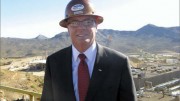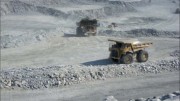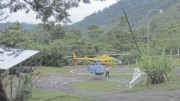Santo Domingo, Dominican Republic — Until last year, Unigold (UGD-V, UGDIF-O) was just another junior Canadian explorer with a large, grassroots gold project and plenty of exploration ideas, but little money to follow them up in any comprehensive way.
That all changed in February 2006 with the transformative entrance of Saudi Arabia’s Shairco For Trading, Industry & Contracting Co. as Unigold’s controlling shareholder — a stake that now stands at 34% — and the simultaneous installation of Saudi mining and business talent at the uppermost levels of Unigold management.
Those active in the titanium dioxide business will be familiar with Jeddah, Saudi Arabia-based Shairco, a 100% family-owned business headed by chairman and president Talal Ali Al-Shair, who founded the company in 1979.
In 2003, Shairco sold its shares in Jeddah-based titanium dioxide manufacturer Cristal (also known as the National Titanium Dioxide Co.) to Saudi-listed National Industrialization Co. (NIC) in return for 23.5% of NIC’s shares, thereby becoming NIC’s largest shareholder.
Al-Shair remains chairman of Cristal, and a director of NIC.
Co-founded by Shairco and now ranking as the largest privately owned chemical company in Saudi Arabia, Cristal has a plant in the Saudi Arabian city of Yanbu that processes titanium sands imported from Australia and Canada. The resulting titanium dioxide product is used in paints, sunscreen lotions and even the writing on M&Ms, and is sold by Cristal into 70 countries.
“I think I’m the only Saudi Arabian who imports sand into Saudi Arabia,” laughs Al-Shair.
Cristal showed its financial muscle and business foresight in 2003 by investing A$40 million and becoming the largest shareholder in Australian-listed and Brisbane-based Bemax Resources (bmx-a) in order to secure a source of rutile-bearing sand for its Yanbu plant.
Topping that, Cristal struck a deal less than two months ago to acquire the titanium dioxide business unit of Houston, Texas-based Lyondell Chemical Co. (LYO-N) for US$1.2 billion in cash, representing Cristal’s first major foray into the U.S. As a result, some 2,900 Lyondell employees in North and South America, Europe and Australia are shifting over to Cristal.
Today, Shairco’s 22.4% stake in NIC is worth about US$1 billion, and Shairco’s overall value is in the neighbourhood of US$1.5-US$1.8 billion.
Shairco remains one of the biggest manufacturers of fiberglass in the Middle East, especially for use in airport passenger terminal furniture; its other businesses include the Dahab gold refinery in Saudi Arabia, which takes in gold from five mines, plus construction, manufacturing and real estate assets.
Al-Shair, who last year added “Unigold chairman” to his list of titles, was university educated in the U.S., having earned a B.Sc. in chemical engineering and an MBA and PhD in international business administration.
Now based in Jeddah, Al-Shair escapes Arabia’s scorching summers by living three months a year in Maine, where he went to grad school.
“Unigold, for me, is something really important,” Al-Shair says, as he makes his first-ever trip to the Dominican Republic to visit government officials and Unigold’s gold properties.
“In Saudi Arabia, everybody is competing in petrochemicals. . . but nobody is doing anything with minerals, or not much,” Al-Shair says. He notes that the Arabian Shield is “one of the richest mineral deposits in the Middle East” and is ignored “simply because there is no know-how” when it comes to minerals and mining in Saudi Arabia.
“Wanting to be different, that led me to get into minerals,” Al-Shair says. “Titanium dioxide happens to be a really good business to be in, and we made good profits for the past ten to eleven years, enough to be able to move into other businesses.”
Al-Shair emphasizes that Shairco doesn’t see Unigold as a company that has mining rights and owns properties, but rather “we look at it as a knowledge-based vehicle that will take us to places, and will continue to learn and have a global outlook.”
In Saudi Arabia, he says, there are very rich deposits for other minerals such as zinc and copper. “We need a vehicle like Unigold that can build a good, strong knowledge base, and that can go to Saudi Arabia and help develop those resources.”
He adds that he’s also looking at resources in Kenya and China, and even here in the Dominican Republic in commodities other than gold.
“In this business, size does matter,” Al-Shair says, “and we really need to take Unigold to the right size where it can get things done the right way.”
Ibrahim Eitani, Unigold’s new Saudi president and CEO, lives in Dubai but acquired bachelor’s, master’s and PhD degrees in mining engineering in the U.S., and has run several mines in Sierra Leone and Saudi Arabia.
He affirms Al-Shair’s sentiments regarding Unigold’s future: “Unigold has no intention of continuing to be an exploration company in the junior leagues. We are looking forward to developing Unigold as a vehicle for future investments, and for mergers and acquisitions, to make sure the future of Unigold is bright.”
Daniel Danis, Unigold’s co-founder and current vice-president of exploration and chief operating officer, first met Eitani in 1998, when Danis was promoting Vogue Resources’ silica-metal project located in Quebec’s Fermont region.
Danis approached Eitani and Shairco regarding Unigold in spring 2005 and, after a long due-diligence period, Shairco invested around $4.5 million in the first half of 2006 to acquire 25 million shares of Unigold, buying in at roughly double the stock’s market price.
At the same time, Eitani was installed as a replacement for John P. Thompson as Unigold president and CEO, and two directors parted. Today, the Unigold board is rounded out with Joseph Del Campo, Edmond Saadah, Jose Ignacio Acero and Jens Hansen.
Just as importantly to Unigold, deep-pocketed Shairco has committed to a one-third lead order in any subsequent financing.
“Two years ago, we were just surviving due to a lack of money, and it was tough on everyone,” Danis says. “Now we’re way better in terms of our cash position, with $7.5 million, and the banker’s on board.”
Other institutional investors in Unigold include Pinetree Capital, Sprott Asset Management and Firebird Global Master Fund.
Some 58 million shares out of 75 million outstanding Unigold shares (89 million fully diluted) are now tightly held.
Candelones gold
For now, Unigold’s flagship is still the Neita gold property, comprised of 226 sq. km centred on the small town of Restauracion, beside the Haitian border.
While a day’s drive from the national capital, infrastructure in the Neita area is good and includes a paved highway and command posts used by the Dominican army to patrol the peaceful border.
Over the past three years at Neita, Unigold has made great strides in improving the understanding of the geological and structural settings of the property’s two key epithermal deposits: Los Candelones and Montazo-Guano.
Candelones is a natural first target for any explorer as it conveniently outcrops in the form of an easily mined silicified hill. It’s Unigold’s most developed deposit, having first been significantly drilled by the French government-owned Bureau de Recherches Gologiques and Minires (BRGM) in 1996-97 (Mitsubishi and others had been in the Neita area in previous decades with less intensive programs).
BRGM’s prefeasibility study of Candelones tallied a mere 161,000 oz. gold in resources, and was very pessimistic about the extent of the deposit.
However, they started with a hypothesis that was wrong: that the Candelones deposit is vertical. As a result, as they drilled it from north to south and reversed the drilling direction halfway along, the southern holes all slipped under the deposit.
Unigold realized the error in 2004-05 and has since been able to extend the deposit significantl
y southwards merely by drilling in the correct direction. As a result, the near-surface gold resource quickly doubled, and the deposit remains wide open for expansion.
Last year, thanks to Shairco’s cash infusion, Unigold was finally able to carry out more comprehensive geophysics, and buy a new core drill from Atlas Copco that can reach 400 metres depth (the old one, still in use, could only probe 100 metres down).
“We hired a top-quality geophysicist and she did an inversion of our induced-polarization data at depth, and this changed our life totally,” Danis says. “Today, our main leader is that we found that the correlation of IP and gold is almost perfect, an eighty-five-per-cent correlation factor. Now my job is way too easy, just punching the IP zones.”
Even compared to three months ago, Danis says, Unigold has a much better understanding of Candelones’ mineralizing system, that it is a fully-grown epithermal system.
“Two years ago, we were thinking a quarter of a million ounces at Candelones,” Danis says. “Today, we’re much more thinking in the million range — it’s changing rapidly.”
‘The Giant’
The Montazo-Guano prospect, 5 km east of Los Candelones, is far more grassroots — with only five closely spaced holes poked into it by BRGM — but it may have more upside than Candelones in the longer term.
Enticingly, Montazo-Guano so far shows the same geological, geophysical and structural signatures as Candelones, but is five times larger: 3 sq. km — or roughly double the geological footprint of Barrick Gold’s (ABX-T, ABX-N) Pueblo Viejo deposit on the other side of the Dominican Republic, but still within the same mineralizing belt.
“At Montazo-Guano we have a huge zone of argillic alteration containing anomalies of gold, barium, antimony, arsenic, cadmium, lead and zinc, plus we have a huge IP anomaly, and a low magnetic anomaly,” says Danis. “These are all the same signatures as Candelones, but much bigger in extent.”
Danis describes Montazo-Guano as “the giant on the Neita property,” and reckons that drilling will get under way there in about three months.
From 1960 until Unigold’s arrival in mid-2002, Neita received some $7 million in exploration work, about half of which was spent at Candelones. Unigold has so far spent another $5 million at Neita, mostly on Candelones.
This year, Unigold has budgeted a further $3.5 million for exploration at Neita, most of which will go into drilling, trenching and more airborne geophysical work. Funds will be split evenly between Candelones, Montazo-Guano and a regional exploration program, especially looking for gold-copper targets along a major 22-km contact zone.
“Trenching for us is doing miracles,” Danis says. “It was with the trenching that we understood all the shifting in the structures and everything. So in the last half year, we trenched over five kilometres in length.”
Aside from more assay results from drill core, Eitani is awaiting results from heap-leaching tests at SGS Lakefield of Candelones mineralized material, which should give a clearer view of potential development paths for any mine.
A new resource calculation and National Instrument 43-101-compliant report for Candelones should be in hand before the end of the third quarter.
On the corporate side, Neita has some very attractive traits: it’s a 100%-owned property with no royalties to be paid and all acquisition commitments met, and there is a minimum 18-year holiday on corporate, sales and import taxes because the Dominican government designated Neita a “fiscal reserve” in 1980 under Law 28-01.
However, this juicy tax holiday doesn’t seem to have created any resentment from today’s Dominican government.
Speaking at a private reception for Unigold and representatives of the Dominican government and business communities, Dominican Director of Mines Octavio Lopez told Unigold management that “we support you, of course. . . Unigold is one of the companies that displays a high level of social and environmental responsibility.”
Lopez said Unigold’s activity “empowers people in Restauracion,” and he had seen Unigold “working with the people, talking with the people, and respecting our environment.”
Lopez said he hopes the “geological theory of a larger gold deposit can be tested in the field and proved correct, because we need this kind of resource. The Dominican Republic is not a mining country, but we want to become one, because we can understand what a contribution sustainable development can make in developing the human beings in the area.”






Be the first to comment on "Site visit: Saudi industrialist transforms Unigold"